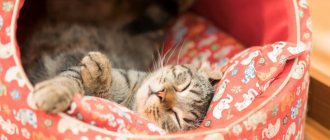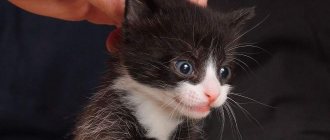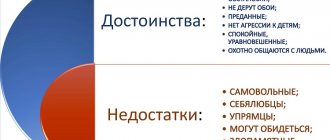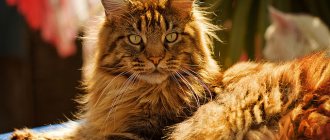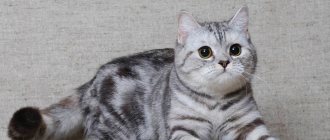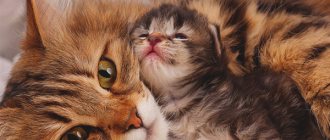Combing
For cats that do not participate in exhibitions, slicker combs cannot be used. They are used only by a professional groomer: for exhibition preparation of hair on certain parts of the animal’s body - on the face and paws. For constant grooming of your Persian cat, it is better to use a steel comb with long, non-sharp teeth.
In order for the procedure of combing fur to become habitual for a Persian, the animal must be accustomed to it from the age of a kitten. Caring for Persian kittens begins with this procedure. For a kitten, combing is more like a game, so the first procedures can be carried out in the form of a game.
The kitten should be placed on its back and first scratched on its neck, belly, and paws. Then, turning him over on his stomach, gently scratch his head and back. It is necessary to repeat the combing procedure daily only during the period of accustoming to it. Then do it regularly 1-2 times a week. Having secured combing, you can move on to teaching him to bathe.
Bathing
Caring for a Persian cat means not only brushing, but also bathing. The optimal number of water treatments for a Persian cat is once every 3-4 weeks. During the molting period, bathing can be made more frequent to prevent the fur from matting.
INTERESTING TO FIND OUT: Does a flea collar help cats?
For bathing, you need to choose the appropriate shampoo for long-haired cats. Usually, Persians, with the right approach to this procedure, quickly get used to it and tolerate it calmly. It is important that the water is warm and does not get into the animal’s ears.
After wetting the cat with water, apply a small amount of shampoo to its fur and foam it over the entire surface of the animal’s body. After washing off the foam, you need to rinse the wool thoroughly with a shower. It is important not to leave any shampoo residue on the coat. Then the whole effect of bathing will go down the drain.
The next step in bathing is drying the coat. First, most of the moisture must be removed with a towel, wrapping the animal in it. Then dry it completely with a hairdryer. An adult animal must also be accustomed to this device from the age of a kitten. Usually adult Persians, accustomed to bathing, endure all its stages, including drying, patiently and with dignity.
A prerequisite for bathing Persian cats is to prevent colds. Therefore, after the water procedure, it must be kept warm, avoiding drafts for 10-12 hours.
Reviews
insex_net
I have a Persian cat, a very cute creature. Playful little joy. The fur really needs to be looked after and combed. In the summer we give her a haircut, the hassle becomes less. We also wipe our eyes every day, they always fester, but it’s true. But how can you ignore this cute face? Since we got her, there has been more joy! She is an extreme sportswoman with us. There are also exotics. She loves to climb flowers, chew wires, and bags are her favorite pastime. Although this is apparently inherent in their nature, in this breed of cats. Well, it's up to you.
n1610
Our Persian is ten years old. The cat is a favorite and a member of the family, he is a smart cat with whom you can negotiate, BUT... They write about this breed - they are kind, affectionate, and playful. Ours is wayward, stubborn, independent and not at all kind. He only allows himself to be loved, but we still love him. As for grooming, you need to teach him to comb his hair and wash himself from childhood. Although we trained and trained, but when I scratch, we hiss and bite, and when I scratch, we scratch and yell, but he allows the muzzle to be washed. When tangles appear, I cut them out with scissors. After washing, I work a little of my hair balm into the wool (less matting), and closer to summer we do a haircut. As for immunity, it’s no weaker than others, the Persians have two problems with their eyes and ears, but we can treat them. Our Ryzhik is a bundle of happiness.
necitbatman
We had a Persian cat at home, very beautiful and fluffy, who lived with us for 11 years. I didn't have to take special care of her, just brush her. If you are not allergic to wool, then there will be no problems. And of course there was fur from her all over the house.
kryjan06skaj
It seems to me that the Persian breed is the kind of cat that children should have. All thanks to their calm nature. When I was a child, I had a Persian cat, I played with it instead of a doll: I swaddled it, put it in a toy stroller, and rolled it. It was possible to walk with her calmly. She behaved wonderfully in her arms. I can’t imagine something like that with a Sphynx or Maine Coon.
Video
Ear and eye care
Due to their long fur, Persians' ears and eyes require regular grooming. Animals' ears should be cleaned weekly with a cotton swab moistened with a special product for caring for cats' ears.
The eyes of Persians constantly secrete a transparent tear secretion. If it is not removed, it can dry out in the form of crusts or leave marks on the face in the form of streaks. To prevent tear secretion from accumulating and drying, it must be removed with a napkin soaked in a special eye care product.
How to care?
In general, regardless of the color of their eyes and fur, Persian cats are balanced and fit perfectly into home life and into the living conditions created by the owner. Education and litter box training go smoothly thanks to the pets’ ability to learn quickly, attentiveness and intelligence. Disapproval from the owner hurts the Persian, but the sensitivity and participation of a person will strengthen mutual affection.
Fluffy pets prefer activity and active games to lying on the owner’s lap or shoulders. Trusting and affectionate, submissive and peaceful, Persians are attached to people, like dogs, and will attract the whole family to watch them. Children should be told that they should not force affection on the pet or forcibly hold it in their arms, but even under such conditions, it will not show aggression or even point a claw.
The food is recommended according to the regimen prescribed by the breeder or veterinarian. Due to the presence of long hair, it is necessary to include a paste in the diet that prevents the formation of hair lumps in the stomach and facilitates exit from the body.
Get vaccinated on time, periodically bathe with special products, comb your hair, trim your claws - that’s all you need to care for your Persian. It’s not easy, but it makes the cat’s life a lot easier.
Take care of the weak point - the eyes, wipe them with a cloth so that the cat does not look like a crybaby. In addition, ignoring this problem leads to thinning of the hair around the eyes. In addition to water, use a mixture of starch, boric alcohol and hydrogen peroxide; purulent discharge requires consultation with a veterinarian. Due to its anatomy, the nose is often blocked; snoring and grunting also require attention. Another vulnerable organ is the kidneys, the diseases of which are genetically determined. Monitor your cat’s health in order to detect deviations from the norm in time!
Persian haircut
Persians, like cats of other domestic breeds, have many owners trim their claws. This is done in order to protect not only the expensive wallpaper on the walls and upholstered furniture, but also the skin of the owners’ hands and feet. For this procedure, you must have a cat nail clipper. The claw must be trimmed skillfully so as not to injure the blood vessel passing inside it.
Grooming of Persian cats for exhibition is carried out in a professional salon by a groomer. Before visiting the salon, the cat should be washed and combed. In addition to decorative haircuts, Persian cats are also given hygienic haircuts.
Nutritional Features
Veterinarians advise choosing the nutrition of Persian cats in accordance with their age and health status. All prepared foods are divided into three groups:
- for young animals;
- for adults;
- for aging animals and animals with special needs (neuters, sterilized cats, patients with chronic diseases, etc.).
Since Persian cats have a tendency to develop kidney diseases, it is worth choosing food for them taking into account the prevention of these diseases.
INTERESTING TO FIND OUT: What happens if a cat's whiskers are trimmed
Persians can also be fed natural products, but be sure to take into account the ratio of nutrients in their diet:
- 40% - clean meat, preferably dietary grades;
- 20% - protein from dairy products and eggs;
- 20% - vegetable fiber;
- 15% - by-products.
For questions about what to feed your Persian cat, when choosing a natural diet for Persians, you should consult a veterinarian.
Diet and feeding methods
First of all, you should decide on the food for your young pet. If you intend to have a Persian baby, you need to ask the seller about the range of food that is familiar to him. It is possible to both prepare food for him yourself and teach him to eat store-bought food.
For animals that are being prepared for an exhibition, the second alternative is better, which provides a clearly harmonized composition of useful components, vitamins and minerals, which ensures proper grooming of the animal and a decent appearance of its fur.
Kittens must be provided with special granules and soft food for small children; after six months they are allowed to be accustomed to adult food. Preference should be given to those that are intended specifically for this breed.
Purebred individuals should be fed special dry food and elite canned food.
At 3 months, the baby needs to eat 6 times a day. By about 6 months, the number of meals is allowed to be reduced to four. Upon reaching the age of one year, the young Persian can be transferred to an adult schedule and given food only a couple of times a day. The constant availability of fresh water, preferably purchased, in a designated container must be ensured.
Kittens are often sloppy when eating; sometimes soft food ends up on their luxurious shirtfront. In this case, you can tie up a special bib for your baby or buy a special bowl for him, which is fixed on a stand.
If your pet still makes a mess while eating, you should wipe off the food with a napkin, because it is difficult for representatives of this breed to make a mess due to the special shape of their muzzle.
The animal's digestive process should be kept under control. In case of indigestion, it is worth changing its menu. Some individuals cannot digest milk and its derivatives well, as well as grain products.
You should not accustom your pet to sweets, prepared meats and foods with a high fat content, such as cream. Exceptional vigilance must be exercised towards White Persians, as they are often prone to allergies, in particular to food.
Diseases of Persian cats
This breed has a hereditary predisposition to certain diseases:
- polycystic kidney disease, which leads to the development of chronic renal failure;
- progressive atrophy of the retina, ending in blindness. This disease can be detected in kittens at two months of age. The disease progresses over 1-2 months, and the animal becomes completely blind.
Other common Persian diseases include:
- tearfulness of the eyes;
- colds that cause breathing problems;
- hypertrophic cardiomyopathy;
- diarrhea due to disruption of the usual diet.
Treatment and prevention of diseases in Persian cats should be done professionally. Therefore, these issues should not be resolved on your own; you should contact veterinarians in specialized clinics.
Mating of Persian cats, pregnancy, childbirth
The cat's first heat occurs between 6 and 12 months. Mating of Persian cats does not last long and must necessarily be accompanied by fixing the cat with his teeth at the withers of the female, otherwise normal fertilization will not occur. Another sign that fertilization has occurred is the cat's cry at the end of coitus.
Pregnancy lasts 63-66 days. But there are cases when Persian cats give birth earlier or later than expected. If this is not due to the cat’s illness or stress, then small deviations of 3-5 days are not a pathology. But you should know that kittens born prematurely (at 58 days) will not be viable.
As a rule, a cat giving birth even for the first time copes with this process on its own. Her instinct will tell you what to do at one time or another. The owner needs to be nearby without interfering with this process. If the birth becomes pathological, then you should seek the help of a veterinarian.
Advantages of the breed
Despite the rather complex content of the Persians, they have many admirers. This breed is one of the most popular among breeders. They are regular participants in various cat shows. This is explained by a number of advantages of this ancient breed:
- good-natured and cheerful disposition;
- in a quiet pleasant voice;
- excellent adaptation in families with children and the elderly.
The life expectancy of Persians is from 10 to 15 years. By bringing a Persian cat into your home, you will get a devoted friend for many years.
Offspring
If you are not planning offspring for your pet, then it is better to subject it to the procedure of castration (for cats) or sterilization (for cats). Such simple operations will deprive you of subsequent headaches, and your pet of physiological and psychological problems.
It is better to subject Persian cats to this procedure at the age of 7 to 10 months; it is during this period that the entire process will be as painless as possible.
Castrated and sterilized animals are less aggressive, do not hold “concerts” at night in search of a soul mate, they do not mark their territory and, moreover, their risk of diseases of the reproductive organs is reduced.

